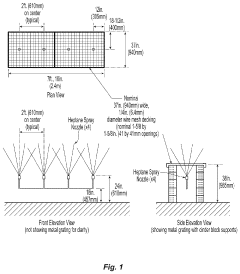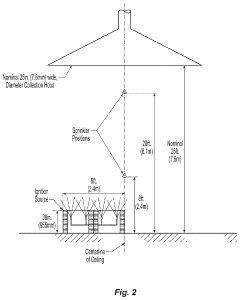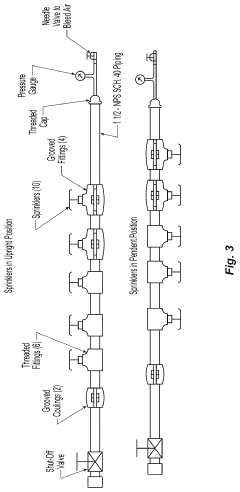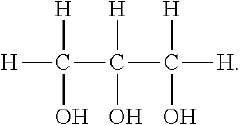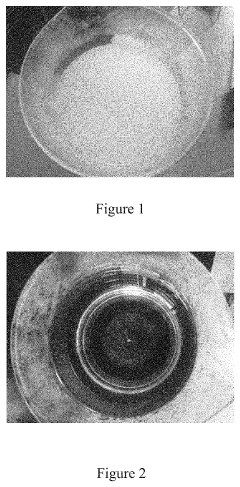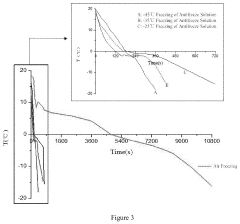Antifreeze in Industrial Applications: Techniques and Trends
JUL 2, 20259 MIN READ
Generate Your Research Report Instantly with AI Agent
Patsnap Eureka helps you evaluate technical feasibility & market potential.
Antifreeze Evolution and Objectives
Antifreeze technology has undergone significant evolution since its inception in the early 20th century. Initially developed for automotive applications, antifreeze solutions have expanded their reach to various industrial sectors, playing a crucial role in maintaining operational efficiency and preventing equipment damage in extreme temperature conditions.
The primary objective of antifreeze in industrial applications is to lower the freezing point of water-based solutions, thereby preventing the formation of ice crystals that could cause damage to machinery and systems. Concurrently, it aims to elevate the boiling point, ensuring stable operation at higher temperatures. This dual functionality has made antifreeze an indispensable component in numerous industrial processes.
Over the years, the composition of antifreeze solutions has evolved from simple alcohol-based formulations to more complex and environmentally friendly alternatives. Early antifreeze solutions primarily consisted of methanol or ethylene glycol. However, concerns about toxicity and environmental impact led to the development of propylene glycol-based formulations, which offer similar performance with reduced health and environmental risks.
Recent advancements in antifreeze technology have focused on enhancing heat transfer properties, improving corrosion protection, and extending the lifespan of industrial equipment. Modern antifreeze solutions often incorporate advanced additives that provide superior protection against cavitation, scaling, and oxidation, thereby significantly reducing maintenance costs and improving overall system efficiency.
The evolution of antifreeze technology has also been driven by the need for specialized solutions in diverse industrial applications. From solar thermal systems to food processing plants, each sector presents unique challenges that require tailored antifreeze formulations. This has led to the development of industry-specific antifreeze products that address particular temperature ranges, material compatibility, and regulatory requirements.
Looking ahead, the objectives for antifreeze technology in industrial applications are multifaceted. There is a growing emphasis on developing more sustainable and biodegradable antifreeze solutions to align with global environmental initiatives. Researchers are exploring novel materials and nanotechnology to create antifreeze formulations with enhanced thermal properties and reduced environmental footprint.
Another key objective is to improve the longevity and stability of antifreeze solutions, reducing the frequency of replacement and minimizing waste. This includes the development of self-healing additives and intelligent monitoring systems that can detect and address issues in real-time, ensuring optimal performance throughout the antifreeze's lifecycle.
The primary objective of antifreeze in industrial applications is to lower the freezing point of water-based solutions, thereby preventing the formation of ice crystals that could cause damage to machinery and systems. Concurrently, it aims to elevate the boiling point, ensuring stable operation at higher temperatures. This dual functionality has made antifreeze an indispensable component in numerous industrial processes.
Over the years, the composition of antifreeze solutions has evolved from simple alcohol-based formulations to more complex and environmentally friendly alternatives. Early antifreeze solutions primarily consisted of methanol or ethylene glycol. However, concerns about toxicity and environmental impact led to the development of propylene glycol-based formulations, which offer similar performance with reduced health and environmental risks.
Recent advancements in antifreeze technology have focused on enhancing heat transfer properties, improving corrosion protection, and extending the lifespan of industrial equipment. Modern antifreeze solutions often incorporate advanced additives that provide superior protection against cavitation, scaling, and oxidation, thereby significantly reducing maintenance costs and improving overall system efficiency.
The evolution of antifreeze technology has also been driven by the need for specialized solutions in diverse industrial applications. From solar thermal systems to food processing plants, each sector presents unique challenges that require tailored antifreeze formulations. This has led to the development of industry-specific antifreeze products that address particular temperature ranges, material compatibility, and regulatory requirements.
Looking ahead, the objectives for antifreeze technology in industrial applications are multifaceted. There is a growing emphasis on developing more sustainable and biodegradable antifreeze solutions to align with global environmental initiatives. Researchers are exploring novel materials and nanotechnology to create antifreeze formulations with enhanced thermal properties and reduced environmental footprint.
Another key objective is to improve the longevity and stability of antifreeze solutions, reducing the frequency of replacement and minimizing waste. This includes the development of self-healing additives and intelligent monitoring systems that can detect and address issues in real-time, ensuring optimal performance throughout the antifreeze's lifecycle.
Industrial Demand Analysis
The demand for antifreeze in industrial applications has been steadily increasing due to the growing need for efficient thermal management systems across various sectors. Industries such as automotive, aerospace, HVAC, and energy production rely heavily on antifreeze solutions to maintain optimal operating temperatures and prevent equipment damage.
In the automotive industry, the global market for antifreeze and coolants is projected to reach significant growth in the coming years. This growth is driven by the increasing production of vehicles worldwide, particularly in emerging economies. The rise of electric vehicles has also created new opportunities for specialized antifreeze formulations designed to cool battery systems and electric motors.
The aerospace sector presents another substantial market for industrial antifreeze applications. As aircraft manufacturers strive for more fuel-efficient designs, the demand for advanced thermal management solutions, including antifreeze compounds, continues to rise. These products play a crucial role in maintaining the performance and safety of various aircraft systems, from hydraulics to de-icing mechanisms.
In the HVAC industry, the push for more energy-efficient and environmentally friendly cooling systems has led to increased demand for innovative antifreeze solutions. This trend is particularly evident in large-scale commercial and industrial HVAC applications, where the need for reliable, long-lasting antifreeze products is paramount.
The energy sector, especially renewable energy technologies like solar thermal and geothermal systems, represents a growing market for industrial antifreeze. As these technologies become more widespread, the demand for specialized heat transfer fluids and antifreeze solutions tailored to their unique requirements is expected to surge.
Environmental concerns and regulatory pressures are shaping the industrial antifreeze market, driving the development of more eco-friendly formulations. There is a growing trend towards biodegradable and less toxic antifreeze products, particularly in industries where environmental impact is a significant consideration.
The industrial antifreeze market is also influenced by technological advancements in materials science and chemistry. Innovations in nanofluid technology and the development of novel additives are opening up new possibilities for more efficient and durable antifreeze solutions. These advancements are expected to further drive market growth and expand the range of applications for antifreeze in industrial settings.
In the automotive industry, the global market for antifreeze and coolants is projected to reach significant growth in the coming years. This growth is driven by the increasing production of vehicles worldwide, particularly in emerging economies. The rise of electric vehicles has also created new opportunities for specialized antifreeze formulations designed to cool battery systems and electric motors.
The aerospace sector presents another substantial market for industrial antifreeze applications. As aircraft manufacturers strive for more fuel-efficient designs, the demand for advanced thermal management solutions, including antifreeze compounds, continues to rise. These products play a crucial role in maintaining the performance and safety of various aircraft systems, from hydraulics to de-icing mechanisms.
In the HVAC industry, the push for more energy-efficient and environmentally friendly cooling systems has led to increased demand for innovative antifreeze solutions. This trend is particularly evident in large-scale commercial and industrial HVAC applications, where the need for reliable, long-lasting antifreeze products is paramount.
The energy sector, especially renewable energy technologies like solar thermal and geothermal systems, represents a growing market for industrial antifreeze. As these technologies become more widespread, the demand for specialized heat transfer fluids and antifreeze solutions tailored to their unique requirements is expected to surge.
Environmental concerns and regulatory pressures are shaping the industrial antifreeze market, driving the development of more eco-friendly formulations. There is a growing trend towards biodegradable and less toxic antifreeze products, particularly in industries where environmental impact is a significant consideration.
The industrial antifreeze market is also influenced by technological advancements in materials science and chemistry. Innovations in nanofluid technology and the development of novel additives are opening up new possibilities for more efficient and durable antifreeze solutions. These advancements are expected to further drive market growth and expand the range of applications for antifreeze in industrial settings.
Antifreeze Technology Challenges
The development and application of antifreeze technologies in industrial settings face several significant challenges. One of the primary issues is the environmental impact of traditional antifreeze formulations. Many conventional antifreeze products contain ethylene glycol, which is toxic to humans and wildlife. As environmental regulations become more stringent, there is a growing need for eco-friendly alternatives that maintain the same level of performance.
Another challenge lies in the corrosion protection capabilities of antifreeze solutions. Industrial systems often involve a variety of metals and alloys, each with different susceptibilities to corrosion. Developing antifreeze formulations that provide comprehensive corrosion protection across diverse materials while maintaining thermal efficiency remains a complex task for researchers and manufacturers.
The increasing demand for high-performance antifreeze solutions in extreme temperature conditions poses another significant challenge. As industrial operations expand into more hostile environments, such as arctic regions or high-altitude locations, antifreeze technologies must evolve to withstand wider temperature ranges without compromising effectiveness or stability.
Compatibility with advanced materials and emerging technologies is an ongoing concern in antifreeze development. As industries adopt new materials and manufacturing processes, antifreeze formulations must be adapted to ensure they do not degrade or react adversely with these novel substrates. This requires continuous research and testing to keep pace with material science advancements.
The quest for improved heat transfer efficiency presents another technical hurdle. While antifreeze solutions are primarily designed to prevent freezing, they also play a crucial role in heat dissipation. Enhancing the thermal conductivity of antifreeze formulations without sacrificing other essential properties is a delicate balancing act that researchers continue to grapple with.
Longevity and stability of antifreeze solutions under prolonged use and varying conditions remain areas of focus. Industrial applications often require antifreeze to maintain its properties over extended periods, resisting degradation from factors such as oxidation, thermal cycling, and contamination. Developing formulations that offer extended service life while minimizing maintenance requirements is a persistent challenge.
Lastly, the cost-effectiveness of new antifreeze technologies presents a significant hurdle. While advanced formulations may offer superior performance, their adoption in industrial settings is often hindered by higher production costs. Striking a balance between enhanced functionality and economic viability is crucial for the widespread implementation of innovative antifreeze solutions across various industrial sectors.
Another challenge lies in the corrosion protection capabilities of antifreeze solutions. Industrial systems often involve a variety of metals and alloys, each with different susceptibilities to corrosion. Developing antifreeze formulations that provide comprehensive corrosion protection across diverse materials while maintaining thermal efficiency remains a complex task for researchers and manufacturers.
The increasing demand for high-performance antifreeze solutions in extreme temperature conditions poses another significant challenge. As industrial operations expand into more hostile environments, such as arctic regions or high-altitude locations, antifreeze technologies must evolve to withstand wider temperature ranges without compromising effectiveness or stability.
Compatibility with advanced materials and emerging technologies is an ongoing concern in antifreeze development. As industries adopt new materials and manufacturing processes, antifreeze formulations must be adapted to ensure they do not degrade or react adversely with these novel substrates. This requires continuous research and testing to keep pace with material science advancements.
The quest for improved heat transfer efficiency presents another technical hurdle. While antifreeze solutions are primarily designed to prevent freezing, they also play a crucial role in heat dissipation. Enhancing the thermal conductivity of antifreeze formulations without sacrificing other essential properties is a delicate balancing act that researchers continue to grapple with.
Longevity and stability of antifreeze solutions under prolonged use and varying conditions remain areas of focus. Industrial applications often require antifreeze to maintain its properties over extended periods, resisting degradation from factors such as oxidation, thermal cycling, and contamination. Developing formulations that offer extended service life while minimizing maintenance requirements is a persistent challenge.
Lastly, the cost-effectiveness of new antifreeze technologies presents a significant hurdle. While advanced formulations may offer superior performance, their adoption in industrial settings is often hindered by higher production costs. Striking a balance between enhanced functionality and economic viability is crucial for the widespread implementation of innovative antifreeze solutions across various industrial sectors.
Current Antifreeze Solutions
01 Composition of antifreeze solutions
Antifreeze solutions typically consist of a mixture of water and chemicals such as ethylene glycol or propylene glycol. These solutions lower the freezing point of water and raise its boiling point, making them effective in preventing freezing in vehicle cooling systems and other applications. Additives may be included to enhance corrosion protection and improve heat transfer properties.- Composition of antifreeze solutions: Antifreeze solutions typically consist of a mixture of water and chemical compounds such as ethylene glycol or propylene glycol. These solutions lower the freezing point of water and raise its boiling point, making them effective in preventing freezing in various applications, including automotive cooling systems.
- Additives for enhanced antifreeze performance: Various additives are incorporated into antifreeze formulations to improve their performance. These may include corrosion inhibitors, anti-foaming agents, and lubricants. Such additives help protect metal components, prevent foam formation, and enhance the overall efficiency of the antifreeze solution.
- Environmental considerations in antifreeze formulations: There is a growing focus on developing environmentally friendly antifreeze solutions. This includes the use of biodegradable components, reducing toxicity, and improving recyclability. Some formulations aim to minimize environmental impact while maintaining effective freeze protection properties.
- Application-specific antifreeze solutions: Antifreeze formulations are tailored for specific applications beyond automotive use. These include solutions for industrial processes, HVAC systems, and even cryogenic applications. The composition and properties of these specialized antifreeze solutions are optimized for their intended use cases.
- Testing and quality control of antifreeze: Various methods and apparatus are used for testing and ensuring the quality of antifreeze solutions. These may include measuring freezing point depression, boiling point elevation, and the concentration of active ingredients. Quality control processes help maintain the effectiveness and reliability of antifreeze products.
02 Environmentally friendly antifreeze formulations
Development of eco-friendly antifreeze solutions focuses on using less toxic alternatives to traditional glycol-based formulations. These may include biodegradable compounds, plant-based ingredients, or other sustainable materials that provide effective freeze protection while minimizing environmental impact.Expand Specific Solutions03 Antifreeze recycling and purification methods
Techniques for recycling and purifying used antifreeze solutions have been developed to reduce waste and environmental contamination. These methods may involve filtration, distillation, or chemical treatments to remove contaminants and restore the antifreeze to a usable condition.Expand Specific Solutions04 Antifreeze applications in energy storage systems
Antifreeze solutions play a crucial role in energy storage systems, particularly in battery thermal management. Specialized formulations are designed to maintain optimal operating temperatures for batteries in electric vehicles and renewable energy storage, improving efficiency and longevity.Expand Specific Solutions05 Antifreeze monitoring and testing technologies
Advanced technologies for monitoring and testing antifreeze solutions have been developed to ensure optimal performance and timely replacement. These may include sensors, analytical devices, or testing kits that can assess the condition of antifreeze in real-time or through periodic checks.Expand Specific Solutions
Key Antifreeze Manufacturers
The antifreeze industry in industrial applications is in a mature stage, with a global market size estimated to reach $7.7 billion by 2027. The technology is well-established, with major players like BASF Corp., Clariant Produkte, and Unilever leading innovation. These companies are focusing on developing eco-friendly and high-performance antifreeze solutions. Emerging trends include the use of bio-based materials and nanotechnology to enhance antifreeze properties. Research institutions like Zhejiang University of Technology and Arizona State University are contributing to advancements in antifreeze technology, particularly in areas such as energy efficiency and environmental sustainability.
BASF Corp.
Technical Solution: BASF Corp. has developed advanced antifreeze solutions for industrial applications, focusing on eco-friendly and high-performance products. Their technology includes the use of propylene glycol-based formulations, which offer improved thermal stability and corrosion protection[1]. BASF's antifreeze solutions incorporate organic acid technology (OAT) additives, providing extended service life and reduced maintenance costs for industrial equipment[2]. The company has also introduced innovative heat transfer fluids that can operate effectively in extreme temperature ranges, from -50°C to 200°C, catering to diverse industrial needs[3].
Strengths: Eco-friendly formulations, extended service life, wide temperature range applicability. Weaknesses: Potentially higher initial costs compared to traditional antifreeze solutions.
Clariant Produkte (Deutschland) GmbH
Technical Solution: Clariant has pioneered the development of bio-based antifreeze solutions for industrial applications. Their technology utilizes renewable raw materials, such as bio-ethanol and bio-glycols, to create environmentally friendly antifreeze products[4]. Clariant's antifreeze formulations incorporate advanced corrosion inhibitors that provide superior protection for various metals commonly used in industrial systems[5]. The company has also developed specialized antifreeze solutions for solar thermal systems, offering enhanced heat transfer properties and long-term stability under high-temperature conditions[6].
Strengths: Sustainable bio-based solutions, advanced corrosion protection, specialized formulations for specific industries. Weaknesses: May have limited availability in some regions, potentially higher production costs.
Innovative Antifreeze Patents
Antifreeze formulations and sprinkler systems comprising improved antifreezes
PatentActiveUS11938361B2
Innovation
- Development of antifreeze formulations comprising water, glycerol, and salts of organic acids with carboxylic acid groups, optimized to maintain a lower freezing point while minimizing heat release and electrical conductivity, using specific buffer agents to stabilize pH and prevent flashovers.
Antifreeze solution for food preservation
PatentActiveUS20190387773A1
Innovation
- An antifreeze solution comprising edible alcohol, propylene glycol, glycerol, calcium chloride, amino acids, Antarctic krill protein hydrolysate, and a surfactant, specifically designed to reduce freezing point, enhance heat transfer efficiency, and inhibit crystallization, with a formulation that minimizes sodium chloride content and includes surfactants to reduce alcohol volatility.
Environmental Impact Assessment
The environmental impact of antifreeze in industrial applications is a critical consideration as the use of these substances becomes more widespread. Traditional antifreeze formulations, often based on ethylene glycol or propylene glycol, have raised concerns due to their potential toxicity and persistence in the environment.
When released into soil or water systems, antifreeze can have detrimental effects on flora and fauna. Ethylene glycol, in particular, is known for its sweet taste, which can attract animals and lead to poisoning. The breakdown of these substances in the environment can also contribute to oxygen depletion in water bodies, affecting aquatic ecosystems.
However, the industry has been making strides in developing more environmentally friendly alternatives. Bio-based antifreezes derived from renewable resources such as corn or soy are gaining traction. These formulations offer comparable performance while reducing the carbon footprint and environmental persistence associated with traditional petroleum-based products.
Another significant trend is the development of antifreeze recycling and reclamation processes. These technologies aim to reduce the volume of antifreeze entering the environment by extending its useful life and properly disposing of spent materials. Advanced filtration and purification methods allow for the removal of contaminants, enabling the reuse of antifreeze in industrial systems.
The regulatory landscape is also evolving to address environmental concerns. Many jurisdictions now classify used antifreeze as hazardous waste, mandating proper handling and disposal procedures. This has led to the establishment of specialized collection and treatment facilities, further mitigating the potential environmental impact.
Manufacturers are increasingly focusing on antifreeze formulations with reduced toxicity and improved biodegradability. Additives that enhance the environmental profile of antifreeze without compromising its performance are being researched and implemented. These include corrosion inhibitors and stabilizers derived from natural sources.
As industrial applications of antifreeze continue to expand, there is a growing emphasis on life cycle assessments to evaluate the overall environmental impact from production to disposal. This holistic approach is driving innovation in manufacturing processes, packaging, and end-of-life management strategies for antifreeze products.
The push for more sustainable industrial practices is also influencing antifreeze usage patterns. Companies are optimizing their systems to minimize antifreeze requirements and implementing closed-loop systems that reduce the risk of environmental release. These efforts, combined with advancements in antifreeze technology, are contributing to a more environmentally responsible approach in industrial applications.
When released into soil or water systems, antifreeze can have detrimental effects on flora and fauna. Ethylene glycol, in particular, is known for its sweet taste, which can attract animals and lead to poisoning. The breakdown of these substances in the environment can also contribute to oxygen depletion in water bodies, affecting aquatic ecosystems.
However, the industry has been making strides in developing more environmentally friendly alternatives. Bio-based antifreezes derived from renewable resources such as corn or soy are gaining traction. These formulations offer comparable performance while reducing the carbon footprint and environmental persistence associated with traditional petroleum-based products.
Another significant trend is the development of antifreeze recycling and reclamation processes. These technologies aim to reduce the volume of antifreeze entering the environment by extending its useful life and properly disposing of spent materials. Advanced filtration and purification methods allow for the removal of contaminants, enabling the reuse of antifreeze in industrial systems.
The regulatory landscape is also evolving to address environmental concerns. Many jurisdictions now classify used antifreeze as hazardous waste, mandating proper handling and disposal procedures. This has led to the establishment of specialized collection and treatment facilities, further mitigating the potential environmental impact.
Manufacturers are increasingly focusing on antifreeze formulations with reduced toxicity and improved biodegradability. Additives that enhance the environmental profile of antifreeze without compromising its performance are being researched and implemented. These include corrosion inhibitors and stabilizers derived from natural sources.
As industrial applications of antifreeze continue to expand, there is a growing emphasis on life cycle assessments to evaluate the overall environmental impact from production to disposal. This holistic approach is driving innovation in manufacturing processes, packaging, and end-of-life management strategies for antifreeze products.
The push for more sustainable industrial practices is also influencing antifreeze usage patterns. Companies are optimizing their systems to minimize antifreeze requirements and implementing closed-loop systems that reduce the risk of environmental release. These efforts, combined with advancements in antifreeze technology, are contributing to a more environmentally responsible approach in industrial applications.
Regulatory Framework for Antifreeze
The regulatory framework for antifreeze in industrial applications is a complex and evolving landscape that aims to ensure safety, environmental protection, and product quality. At the international level, organizations such as the United Nations Economic Commission for Europe (UNECE) have established guidelines for the transport of dangerous goods, which include certain antifreeze formulations.
In the United States, the Environmental Protection Agency (EPA) plays a crucial role in regulating antifreeze under the Toxic Substances Control Act (TSCA). The EPA mandates proper disposal methods and encourages recycling of used antifreeze to minimize environmental impact. Additionally, the Occupational Safety and Health Administration (OSHA) sets standards for workplace safety related to antifreeze handling and storage.
The European Union has implemented REACH (Registration, Evaluation, Authorization, and Restriction of Chemicals) regulations, which apply to many antifreeze components. These regulations require manufacturers and importers to assess and manage the risks associated with the substances they produce or import, ensuring their safe use throughout the supply chain.
In Asia, countries like China and Japan have their own regulatory frameworks. China's Ministry of Ecology and Environment oversees the management of hazardous chemicals, including certain antifreeze formulations. Japan's Chemical Substances Control Law (CSCL) regulates the manufacture, import, and use of chemical substances, impacting antifreeze production and distribution.
Many countries have specific regulations regarding the use of ethylene glycol, a common antifreeze component, due to its toxicity. Some jurisdictions mandate the addition of bittering agents to ethylene glycol-based antifreeze to prevent accidental ingestion by children and animals.
The automotive industry, a major user of antifreeze, faces stringent regulations. In the EU, the End-of-Life Vehicles Directive requires the proper disposal and recycling of vehicle fluids, including antifreeze. Similar regulations exist in other regions, promoting responsible handling of antifreeze throughout a vehicle's lifecycle.
As environmental concerns grow, there is an increasing trend towards regulations that promote the use of more environmentally friendly antifreeze formulations. This includes incentives for developing and adopting propylene glycol-based or organic acid technology (OAT) antifreeze solutions, which are less toxic and more biodegradable than traditional ethylene glycol-based products.
In the United States, the Environmental Protection Agency (EPA) plays a crucial role in regulating antifreeze under the Toxic Substances Control Act (TSCA). The EPA mandates proper disposal methods and encourages recycling of used antifreeze to minimize environmental impact. Additionally, the Occupational Safety and Health Administration (OSHA) sets standards for workplace safety related to antifreeze handling and storage.
The European Union has implemented REACH (Registration, Evaluation, Authorization, and Restriction of Chemicals) regulations, which apply to many antifreeze components. These regulations require manufacturers and importers to assess and manage the risks associated with the substances they produce or import, ensuring their safe use throughout the supply chain.
In Asia, countries like China and Japan have their own regulatory frameworks. China's Ministry of Ecology and Environment oversees the management of hazardous chemicals, including certain antifreeze formulations. Japan's Chemical Substances Control Law (CSCL) regulates the manufacture, import, and use of chemical substances, impacting antifreeze production and distribution.
Many countries have specific regulations regarding the use of ethylene glycol, a common antifreeze component, due to its toxicity. Some jurisdictions mandate the addition of bittering agents to ethylene glycol-based antifreeze to prevent accidental ingestion by children and animals.
The automotive industry, a major user of antifreeze, faces stringent regulations. In the EU, the End-of-Life Vehicles Directive requires the proper disposal and recycling of vehicle fluids, including antifreeze. Similar regulations exist in other regions, promoting responsible handling of antifreeze throughout a vehicle's lifecycle.
As environmental concerns grow, there is an increasing trend towards regulations that promote the use of more environmentally friendly antifreeze formulations. This includes incentives for developing and adopting propylene glycol-based or organic acid technology (OAT) antifreeze solutions, which are less toxic and more biodegradable than traditional ethylene glycol-based products.
Unlock deeper insights with Patsnap Eureka Quick Research — get a full tech report to explore trends and direct your research. Try now!
Generate Your Research Report Instantly with AI Agent
Supercharge your innovation with Patsnap Eureka AI Agent Platform!
